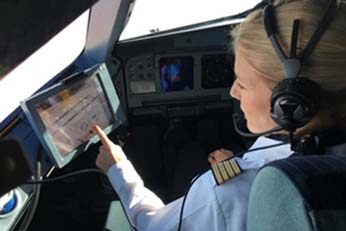
On time, resilient and seamless traffic in European airspace requires a modernised air transport system. In connection with the SESAR 2020 research project Integrated Airport Operations, the Airspace User Demonstration AUDIO (Airspace User supporting Demonstration of Integrated Airport Operations) has been launched. The demonstration project, funded by the European Union, aims to improve safety, efficiency and predictability of flights by increasing the flight crew's situational awareness while the aircraft is taxiing.
In the next 20 years, the frequency of air travel for the average citizen will increase by one to two percent per year in developed countries, according to a recent IATA forecast. This means new challenges for airports and pilots, who will have to manage increased congestion whilst maintaining safety.
To ensure timely arrivals and smooth baggage claims, but also to improve environmental performance by reducing fuel consumption, Europe's Air Traffic Management (ATM) system needs constant updates. Steffen Loth, coordinator of the newly launched AUDIO (Airspace User supporting Demonstration of Integrated Airport Operations) project at the German Aerospace Center (DLR), explains: "Promising new solutions for airport operators and air navigation service providers are almost ready for deployment at European airports. Pre-operational trials have shown safety and efficiency benefits of these new solutions. For an integrated approach to a modernized air transport, we need to go beyond these ground-based solutions, involve airlines as central partners and share available information between all stakeholders."
Providing additional information to the cockpit
Cockpit crews currently have access to information such as the digital layout of airports or a graphical representation of their own position through what is called the Electronic Flight Bag (EFB) System. AUDIO proposes to provide additional data, traditionally available to controllers only.
In a real-life demonstration at Hamburg airport, AUDIO will demonstrate the viability of an innovative advanced and connected moving map application, developed under a previous EU funded project. The application provides the cockpit with local airport data such as the on-ground traffic situation and planned taxi routes.
Safer planning, more fluidity, less stress
Equipped with this additional information, on-board operations are expected to run smoother as crews are aware of the planned ground trajectory and the surrounding complex environment. This also allows them to react more easily to last-minute re-planning of routes once the aircraft is off-block. The results: a safer sequence, a more reliable targeted take-off time, less complexity for the crew, more efficient taxiing and fewer emissions due to lower fuel consumption. AUDIO will also make sure that this innovative application is easily accepted by pilots, airlines, manufacturers and other stakeholders in the ATM community and prepare its market uptake.
Four experienced European partners join forces in AUDIO
AUDIO is coordinated by DLR, which provides ground information, flight plan and route information collected by the Airport Research and Innovation platform (ARIF) in Hamburg, Germany. Deutsche Lufthansa will adapt the existing EFB solutions, oversee the demonstration at Hamburg Airport and evaluate them under real-life conditions and coordinate with safety authorities, including EASA. Norway-based SINTEF provides the SESAR solutions to be used for the demonstration. French management consultancy ARTTIC will ensure the dissemination of the project's results and achievements.
AUDIO is funded under the SESAR 2020 programme through a specific call within the European Union's Horizon 2020 framework programme for Research & Innovation, specifically aiming to modernize the air traffic management system. A total of 1.06 million Euros has been awarded to the consortium to run the project over two years
